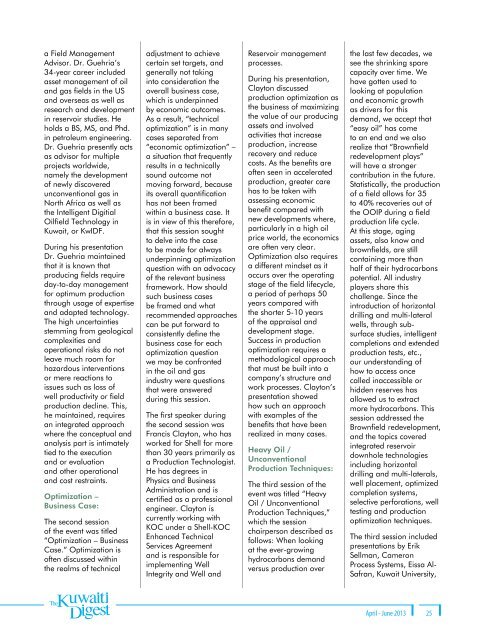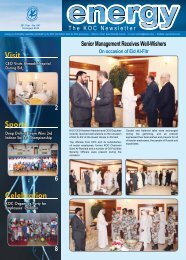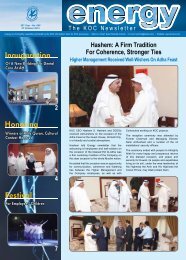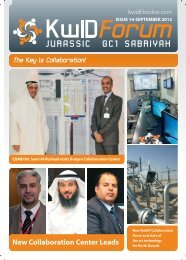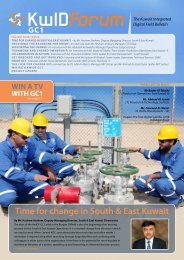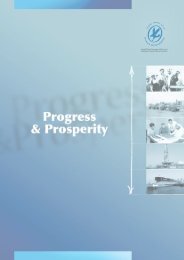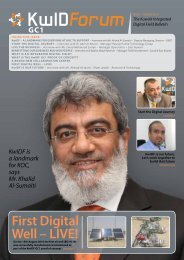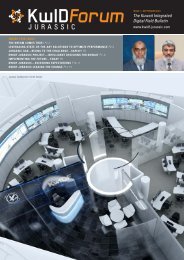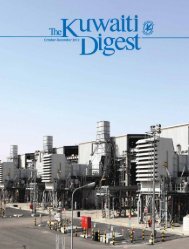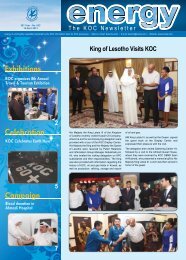6 - Kuwait Oil Company
6 - Kuwait Oil Company
6 - Kuwait Oil Company
You also want an ePaper? Increase the reach of your titles
YUMPU automatically turns print PDFs into web optimized ePapers that Google loves.
a Field Management<br />
Advisor. Dr. Guehria’s<br />
34-year career included<br />
asset management of oil<br />
and gas fields in the US<br />
and overseas as well as<br />
research and development<br />
in reservoir studies. He<br />
holds a BS, MS, and Phd.<br />
in petroleum engineering.<br />
Dr. Guehria presently acts<br />
as advisor for multiple<br />
projects worldwide,<br />
namely the development<br />
of newly discovered<br />
unconventional gas in<br />
North Africa as well as<br />
the Intelligent Digitial<br />
<strong>Oil</strong>field Technology in<br />
<strong>Kuwait</strong>, or KwIDF.<br />
During his presentation<br />
Dr. Guehria maintained<br />
that it is known that<br />
producing fields require<br />
day-to-day management<br />
for optimum production<br />
through usage of expertise<br />
and adapted technology.<br />
The high uncertainties<br />
stemming from geological<br />
complexities and<br />
operational risks do not<br />
leave much room for<br />
hazardous interventions<br />
or mere reactions to<br />
issues such as loss of<br />
well productivity or field<br />
production decline. This,<br />
he maintained, requires<br />
an integrated approach<br />
where the conceptual and<br />
analysis part is intimately<br />
tied to the execution<br />
and or evaluation<br />
and other operational<br />
and cost restraints.<br />
Optimization –<br />
Business Case:<br />
The second session<br />
of the event was titled<br />
“Optimization – Business<br />
Case.” Optimization is<br />
often discussed within<br />
the realms of technical<br />
adjustment to achieve<br />
certain set targets, and<br />
generally not taking<br />
into consideration the<br />
overall business case,<br />
which is underpinned<br />
by economic outcomes.<br />
As a result, “technical<br />
optimization” is in many<br />
cases separated from<br />
“economic optimization” –<br />
a situation that frequently<br />
results in a technically<br />
sound outcome not<br />
moving forward, because<br />
its overall quantification<br />
has not been framed<br />
within a business case. It<br />
is in view of this therefore,<br />
that this session sought<br />
to delve into the case<br />
to be made for always<br />
underpinning optimization<br />
question with an advocacy<br />
of the relevant business<br />
framework. How should<br />
such business cases<br />
be framed and what<br />
recommended approaches<br />
can be put forward to<br />
consistently define the<br />
business case for each<br />
optimization question<br />
we may be confronted<br />
in the oil and gas<br />
industry were questions<br />
that were answered<br />
during this session.<br />
The first speaker during<br />
the second session was<br />
Francis Clayton, who has<br />
worked for Shell for more<br />
than 30 years primarily as<br />
a Production Technologist.<br />
He has degrees in<br />
Physics and Business<br />
Administration and is<br />
certified as a professional<br />
engineer. Clayton is<br />
currently working with<br />
KOC under a Shell-KOC<br />
Enhanced Technical<br />
Services Agreement<br />
and is responsible for<br />
implementing Well<br />
Integrity and Well and<br />
Reservoir management<br />
processes.<br />
During his presentation,<br />
Clayton discussed<br />
production optimization as<br />
the business of maximizing<br />
the value of our producing<br />
assets and involved<br />
activities that increase<br />
production, increase<br />
recovery and reduce<br />
costs. As the benefits are<br />
often seen in accelerated<br />
production, greater care<br />
has to be taken with<br />
assessing economic<br />
benefit compared with<br />
new developments where,<br />
particularly in a high oil<br />
price world, the economics<br />
are often very clear.<br />
Optimization also requires<br />
a different mindset as it<br />
occurs over the operating<br />
stage of the field lifecycle,<br />
a period of perhaps 50<br />
years compared with<br />
the shorter 5-10 years<br />
of the appraisal and<br />
development stage.<br />
Success in production<br />
optimization requires a<br />
methodological approach<br />
that must be built into a<br />
company’s structure and<br />
work processes. Clayton’s<br />
presentation showed<br />
how such an approach<br />
with examples of the<br />
benefits that have been<br />
realized in many cases.<br />
Heavy <strong>Oil</strong> /<br />
Unconventional<br />
Production Techniques:<br />
The third session of the<br />
event was titled “Heavy<br />
<strong>Oil</strong> / Unconventional<br />
Production Techniques,”<br />
which the session<br />
chairperson described as<br />
follows: When looking<br />
at the ever-growing<br />
hydrocarbons demand<br />
versus production over<br />
the last few decades, we<br />
see the shrinking spare<br />
capacity over time. We<br />
have gotten used to<br />
looking at population<br />
and economic growth<br />
as drivers for this<br />
demand, we accept that<br />
“easy oil” has come<br />
to an end and we also<br />
realize that “Brownfield<br />
redevelopment plays”<br />
will have a stronger<br />
contribution in the future.<br />
Statistically, the production<br />
of a field allows for 35<br />
to 40% recoveries out of<br />
the OOIP during a field<br />
production life cycle.<br />
At this stage, aging<br />
assets, also know and<br />
brownfields, are still<br />
containing more than<br />
half of their hydrocarbons<br />
potential. All industry<br />
players share this<br />
challenge. Since the<br />
introduction of horizontal<br />
drilling and multi-lateral<br />
wells, through subsurface<br />
studies, intelligent<br />
completions and extended<br />
production tests, etc.,<br />
our understanding of<br />
how to access once<br />
called inaccessible or<br />
hidden reserves has<br />
allowed us to extract<br />
more hydrocarbons. This<br />
session addressed the<br />
Brownfield redevelopment,<br />
and the topics covered<br />
integrated reservoir<br />
downhole technologies<br />
including horizontal<br />
drilling and multi-laterals,<br />
well placement, optimized<br />
completion systems,<br />
selective perforations, well<br />
testing and production<br />
optimization techniques.<br />
The third session included<br />
presentations by Erik<br />
Sellman, Cameron<br />
Process Systems, Eissa Al-<br />
Safran, <strong>Kuwait</strong> University,<br />
April - June 2013 25


